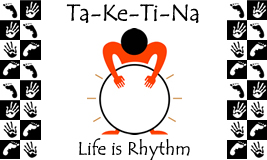
Taketina Workshops in the UK
27th and 28th Sep 2014
London School of Capoeira
Units 1 & 2 Leeds Place Tollington Park London N4 3RF
"This workshop is both revelatory and fundamental to acquiring and working with rhythm on stage. ...Working with the basics of rhythm in this way is, I believe, as essential to one's stage presence as the discipline of 'The Neutral Mask.' "
Simon McBurney, Theatre de Complicite.
TaKeTiNa Develops Rhythmic Awareness
TaKeTiNa is a musical, meditative yet lively group process for re-connecting us to the natural rhythmic ability that already lies there within us all

Taketina is comprised of 3 layers of voice, claps, and steps, which are gently built up sequentially in simple spacious stages, woven together to form surprisingly complex poly-rhythms. Vocal and clap rhythms are accompanied by the berimbau, while the steps are supported by a surdo drum. The voice and claps shift in and out of sync while the dance steps remain the same. The drum grounds the stepping, and varying call and response chanting destabilizes and re-stabilizes the rhythmic movements. This dynamic tension between order and chaos allows you to repeatedly fall out, and then fall back into rhythm, so you become aware of any unnecessary effort you are making, and then you discover that you can just let yourself be more and more in the rhythm. This builds deep musical confidence and personal trust. You experience the resilience of rhythm archetypes, rhythmic images anchored deep in human consciousness. The voice is a bridge between rhythm and movement
The body becomes rhythm
Taketina works for everyone, regardless of your level of musical ability, from the rhythmically dyslexic to professional percussionists.
It's safe and fun, nobody is in the "spotlight" as everyone is simultaneously going through their own process whilst being supported by the rhythm of the group as a whole.
For a more detailed description and explanation of Taketina please press the ABOUT tab at the top of the page.